

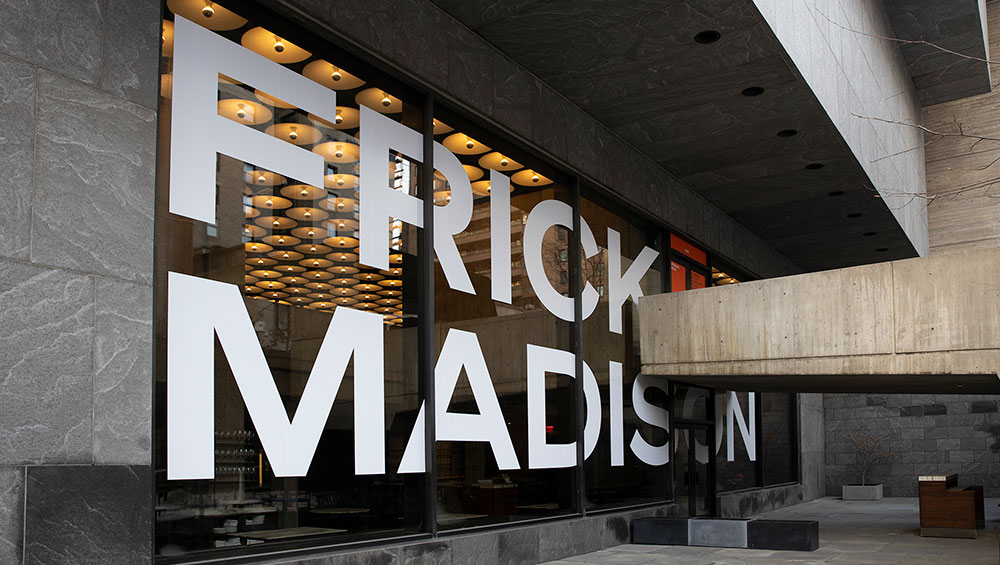
Exterior of Frick Madison. Photo: Joe Coscia, courtesy The Frick Collection.
by JILL SPALDING
Dislocation, dislocation, dislocation! Flipping the tried and true real-estate mantra for what sells and compels applies to the Frick Collection’s inspired campout on Madison. Long in the planning, the transfer is nonetheless serendipitous, opening one week after a $69m (£50m) non-fungible token (NFT) gave art a new direction. How new is brought home by first parsing Beeple’s 5,000 pixelated images on line, then immersing yourself here in the most traditional forms of art-making.
The most noble of displaced persons, standouts from Henry Clay Frick’s storied Gilded Age collection have been driven by the exigencies of expansion from the domestic intimacy of his Fifth Avenue home to a two-year residency in Marcel Breuer’s brutalist building.
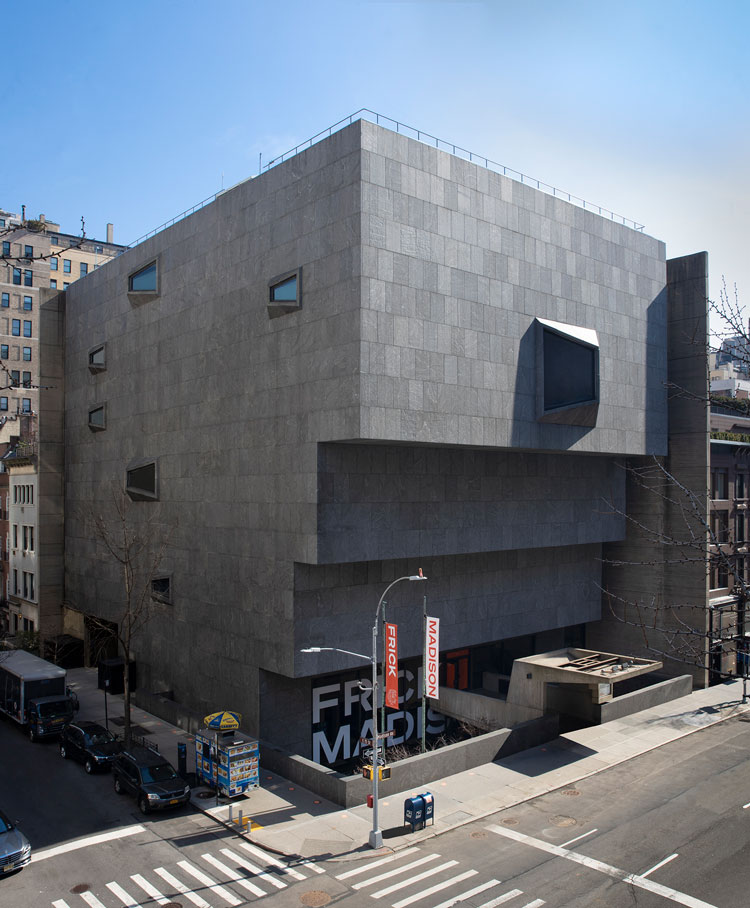
Marcel Breuer building. Photo: Joe Coscia, courtesy The Frick Collection.
More feared than anticipated (laid end-to-end, the published protests would cloak Central Park), the move has resulted in a happy collusion of masterpieces. With a sensitivity that augurs well for her firm’s redo of the mansion, Annabelle Selldorf applied lessons learned from marrying art to architecture at Manhattan’s Neue Galerie and the David Zwirner 19th Street gallery to lodging refulgent artworks in an upside-down ziggurat. Far more than a reshuffle – though the regrouping by place and era is in itself refreshing – framing the classics with bluestone floors, bespoke walls, concrete-coffered ceilings and a genius interplay of track-and-street lighting has brilliantly rethought them for the 21st century. Far more than a rehanging, set off here against the grey of a slow dawn, even the least of the works self-identifies with a clarity that its genteel juxtaposition to drapes and fireplaces had softened. Timed viewing enables private moments with favourites, which for maximum impact have themselves been socially distanced, and the dislocation realigning superstars we may have taken for granted has revitalised them. More kudos to the curators for not having cordoned off close communion with the famous and fragile. Joy aside, the instructional value of closing in on a slash of white linen, a shimmer of taffeta, a fallen leaf, a breath of cloud, is worth a year in the classroom.
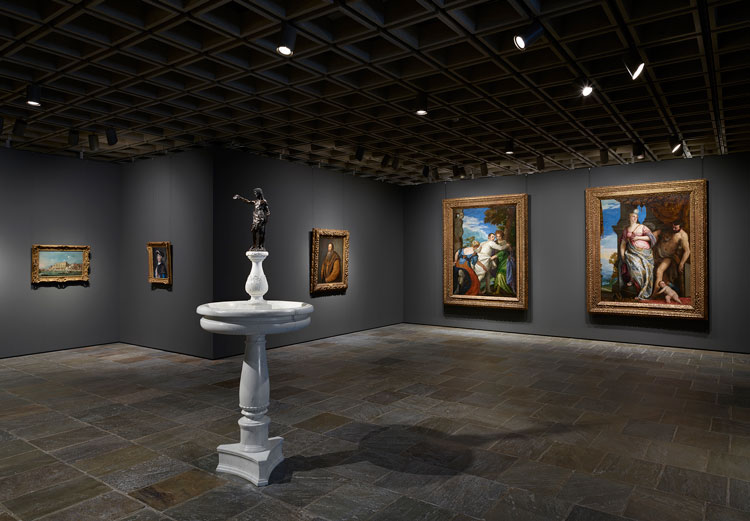
Room 11: This grand gallery of Italian Renaissance paintings includes work by Veronese (back right wall) as well as Titian. Centrally located is a bronze by Francesco da Sangallo, placed atop a replica of its original base. To the left, in Room 12, are works by later Venetian masters Guardi, Tiepolo, and Carriera. Photo: Joe Coscia, courtesy The Frick Collection.
If you are one for chronology, begin on the third floor with the early Italians (most acquired after Frick’s death by his equally impassioned daughter). Spend a moment to reacquaint yourself with the radiance of gold and first essays in perspective before you surrender to the embrace of the great Piero della Francesca. Wrapped in the lush robes of the era’s emerging Man Incarnate, his St John the Evangelist (sole survivor of the five saints folded into a lost altarpiece) holds, as if instructing the world, his Book of Revelations: such is the mastery of colour and perspective as to justify Aldous Huxley’s anointing Piero’s kindred Resurrection of Christ the “best painting in the world”.
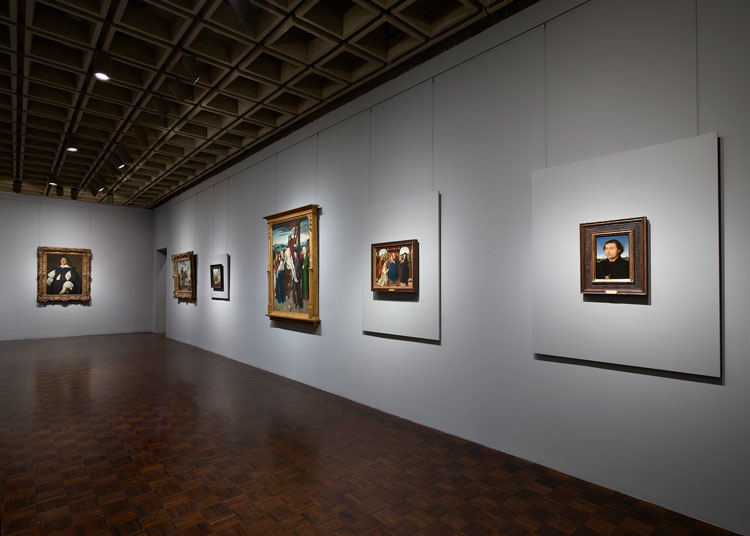
Room 2: Early Netherlandish painting (1440–1570) by Memling (foreground), Van Eyck, David, and others, as shown at Frick Madison by The Frick Collection. Photo: Joe Coscia, courtesy The Frick Collection.
The second floor should open to trumpets so grand are its offerings. Three of the only known 34 Johannes Vermeer paintings in one room – a show within a show, related by their cryptic ambiguity. No surprise that Rembrandt’s 1658 Self-Portrait still skewers. Yes, it is just one of the 50-plus that he painted, but – as could be said of each of the late self-portrait trifecta (at the Mauritshuis, Kenwood House, and National Gallery of Art) this is the one – overpowering for the expression of loss, wear and penury achieved with, as George Condo put it, “just paint”.
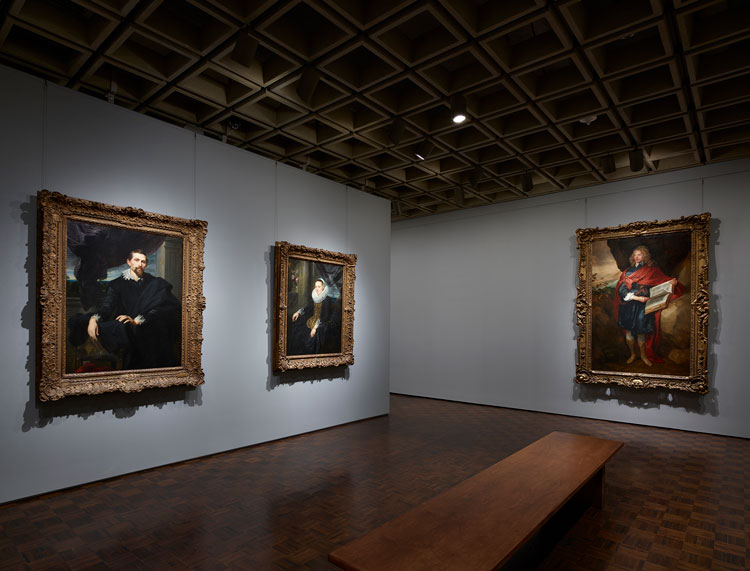
Room 5: Three of the Frick’s eight portraits by Van Dyck, as shown at Frick Madison by The Frick Collection. Photo: Joe Coscia, courtesy The Frick Collection.
Conversely, the insightful life-spanning assemblage (all eight!) of the Frick’s Anthony van Dycks discloses the evolving perception of an artist whose early and seemingly facile mastery of technique has too readily catalogued him with his fellow knighted colleagues. Wash your mental palate clean of English portraiture and you’ll see a direct link to the Flemish artist’s mentor, Peter Paul Rubens. Their interplay and astute lighting reveal the mastery that (twice) imported Van Dyck to the court of Louis XIII for a series of portraits – 24 amassed by Mazarin, including the formidable Marie de Medici now in Bordeaux’s Musée des Arts.
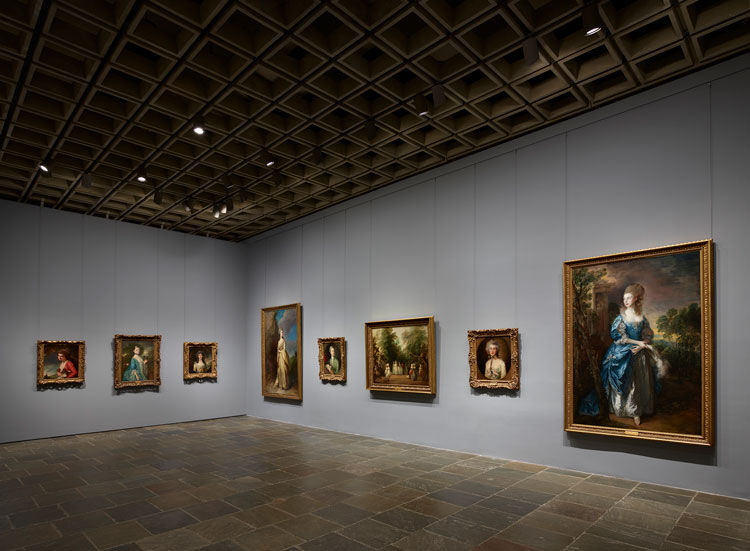
Room 21: The Frick Collection is home to remarkable works of British portraiture, many seen in this gallery, with works by Gainsborough on the right wall. Photo: Joe Coscia, courtesy The Frick Collection.
The fourth floor, although awash in the laborious craftsmanship of the métiers that birthed the glory and doom of a blithe aristocracy, is as stimulating as a marvellous party. Among the gladdening guests are five stylish Gainsboroughs – commissioned status-portraits of upper-class privilege by 18th-century England’s most celebrated painter that were acquired to splendidly host Frick’s gilded gatherings. Displaced from their decorous domain and asked to preside here solely on merit, their chilly elegance surrenders to the close viewing of a master’s brush put to roseate petals and intricate foliage that foreshadowed the dawn of Romanticism. Released from its corset at the Frick, The Promenade begs a rethink of chic-to-dismiss Pierre-Auguste Renoir by bringing us face to face with the delicate washes and bold impasto – so startling in their day – that established impressionism. Unexpectedly moving, Still Life with Plums, an all-but-animated study of juxtaposed forms, justifies art historian John Walsh’s assessment of Jean-Siméon Chardin as “the greatest still-life painter ever”.
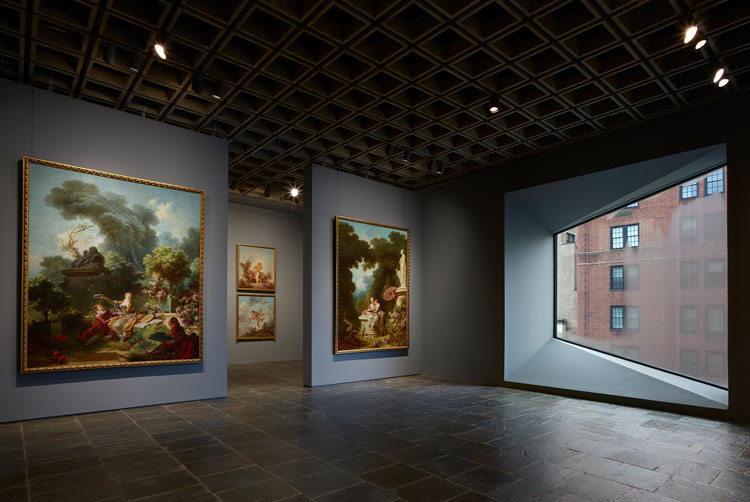
Room 24: Four grand panels of Fragonard’s series The Progress of Love are shown together at Frick Madison in a gallery illuminated by one of Marcel Breuer’s trapezoidal windows. This view shows two of the 1771–72 paintings, with two later overdoors visible in the next gallery. Photo: Joe Coscia, courtesy The Frick Collection.
Greatest the surprise of the fluidly transposed The Progress of Love. Thought inextricably rooted in their dedicated Fifth Avenue Fragonard Room where they backdrop the furnishings as a sort of visual muzak, here they are, the four monumental canvases, together again. What stuns is how, freed from Frick’s domestic paraphernalia, they play off each other as one dazzling work – a phoenix arisen from the day’s Salon des Refusés in the person of the Comtesse du Barry, Louis XV’s last maîtresse-en-titre, who famously rejected them as dated (although, in fairness to Madame’s impeccable taste, they were probably commissioned by the project’s architect, Claude Ledoux, and by delivery the fashion for rococo was indeed over). Fashion never mattered to JP Morgan, who pounced on the set plus the 10 companion panels Fragonard later added for a villa down south. A passion as much for all things Morgan as French came to lodge them as prettily under Henry Clay’s roof. Lovely as they looked there, they read as decor, but visit them here and add Fragonard to the pantheon. Though still a tutti-frutti of confections, left to dialogue with each other against walls doubling as sky, the trees glisten like silk, the silks flicker like sunlight, and the sunlight shimmers into an eternal afternoon of coded ecstasy (columns, ladder, putto statue and Eros himself).
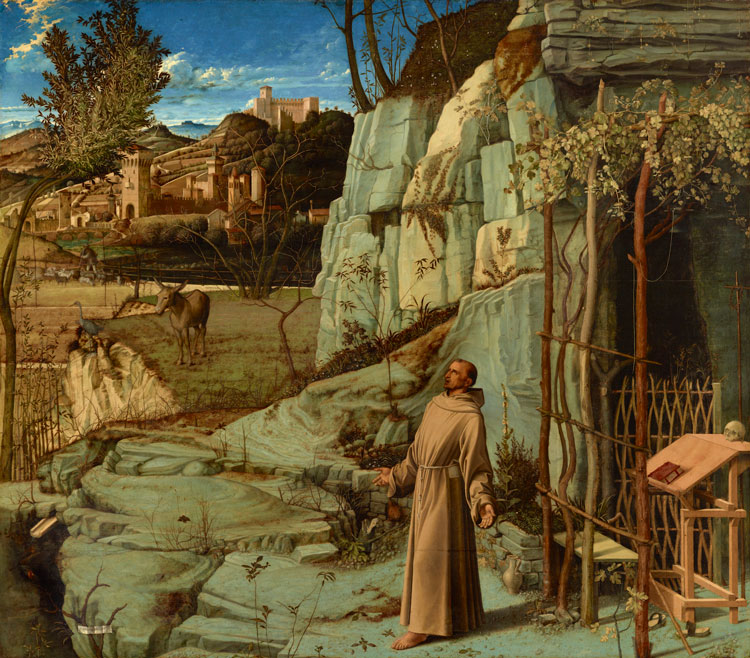
Giovanni Bellini. St. Francis in the Desert, c1476–78. Oil on panel; panel: 49 1/16 x 55 7/8 in; image: 48 7/8 x 55 1/16 in. The Frick Collection, New York. Photo: Michael Bodycomb, courtesy The Frick Collection / Frick Art Reference Library.
Out of order, I know, but if you want to go out with a bang, save Giovanni Bellini’s justly venerated St Francis in the Desert for last, and brace yourself: the cherry on the top of Frick Madison’s sweet treats, the storied painting – an unqualified masterpiece – is not so much advantaged by the move as transfixed by it. Nothing can prepare you for the soul-shaking, light-greeting-light fusion of sacred and secular devolving from its catty-corner positioning on to the Breuer’s signature trapezoidal window. You could pop in between errands to visit this one room, this one painting, and be satiated.
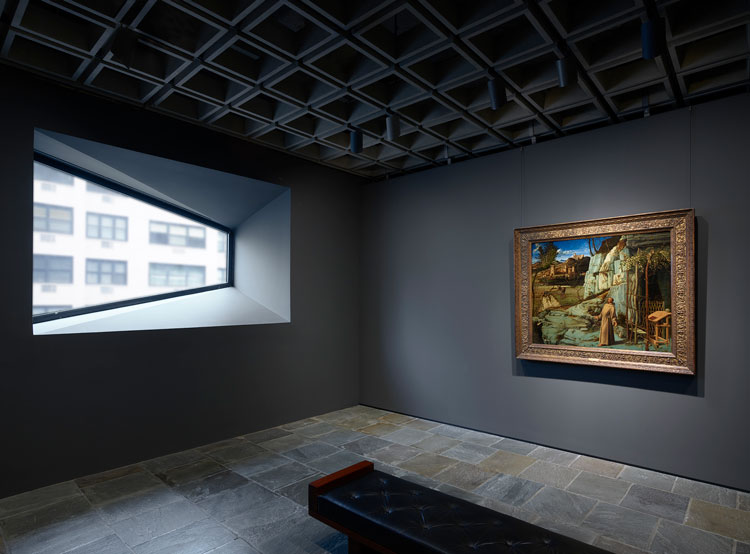
Room 13: Bellini’s St. Francis in the Desert, one of the Frick’s most important and loved works, is displayed in isolation, paired with one of the iconic trapezoidal windows Marcel Breuer conceived for the building. Photo: Joe Coscia, courtesy The Frick Collection.
Not all have been so advantaged. The glorious Turners, in their old habitat virtually irradiated by the ambient lighting into a spiritual experience, convert here to an admirable exercise in a revolutionary technique that track-lighting presents as overcleaned. The same applies to the Whistlers, the courtly American painter whose bolder work scandalised (“a pot of paint”, railed John Ruskin) but whose portraits (so carefully collected and dear to Frick’s heart) convened here in a brightly lit cubicle line up more like trading cards – the thinly applied paint leaving them polite, wan and lifeless.
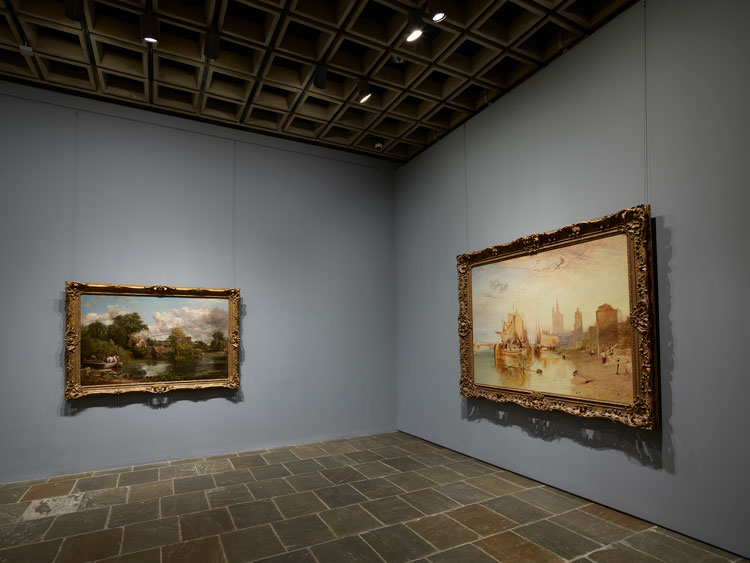
Room 20: Works by British landscape rivals Turner (right) and Constable (left) are shown in this gallery. Photo: Joe Coscia, courtesy The Frick Collection.
Playing favourites, I should like to have highlighted the Constable, whose “six-footer” landscapes handily out-paint Ruysdael’s, but that The White Horse, perhaps given too much wall space, disappoints here. The strutting Velázquez portrait of Philip IV cedes command of the Spanish paintings to El Greco’s far smaller but searing Purification of the Temple, effected with an explosive asymmetry of diagonals, colouration and distortion. Most unexpectedly, I had to remind myself that the beloved Ingres portrait of a fetishised Comtesse d’Haussonville (the accomplished biographer, pianist and watercolourist whom her mother described as “a vase without arms”) is justly famed for its artistry because, frontally lit, the creamy skin and dreamy reverie present less as nonpareil technique achieved through years of apprenticeship than as the digital wizardry of a cut-paste-and-post NFT.
More interesting than worthy are two renderings by the 17th-century Venetian society portraitist Rosalba Carriera, recently donated to fill the long-overdue slot of neglected female artists. Charming and accomplished, they are no Gentileschis but, reflecting Frick’s taste, serve to raise the age-old question: “Who chooses the art and hangs the paintings that have written cultural history?” As these lovely portraits relay, just as taste has been the builder of collections through time, taste is the divider between this collection and the blockchain.
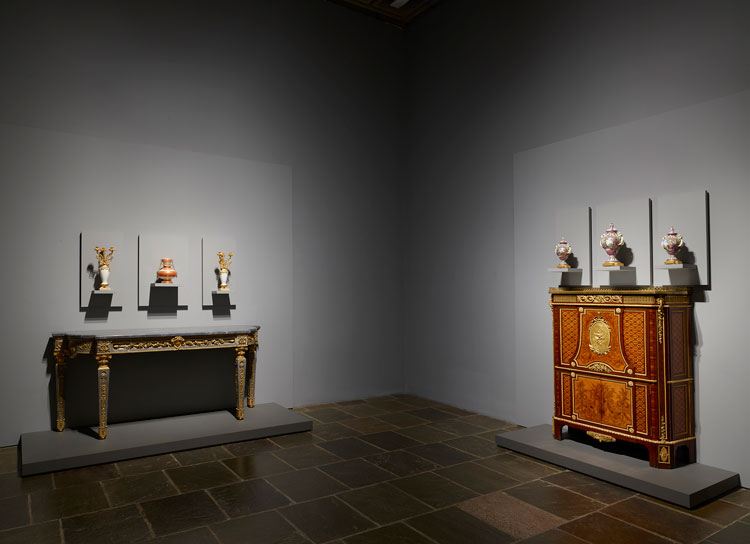
Room 19: In this gallery of French decorative arts, a remarkable side table of blue Turquin marble and gilt-bronze mounts by Pierre Gouthière is shown with a secretaire by Riesener commissioned for Marie- Antoinette. Additional works by Gouthière and Sèvres are displayed above these important pieces of furniture. Photo: Joe Coscia, courtesy The Frick Collection.
Of the objects and furnishings, all generic to the Frick’s niches and alcoves, few gain by runway exhibition. A treat, though, to come within touching distance of the secretaire fashioned for Marie Antoinette by the great Jean-Henri Riesener and to examine up close the tour-de-force workmanship of the two sumptuous silk and pashmina wool Mughal carpets (rare survivors of over-usage) despite the top-heavy wall hanging of what – to their detriment – had splendidly served imperial foot-traffic.
The bronzes hold their own (indeed, the third floor aha elevator moment – at the Whitney-Breuer’s closing biennial given to Jeff Koons’s scatalogical Made in Heaven Cicciolina – opens on the Frick’s beatifically beautiful Angel by Jean Barbet, Lyon’s you-can’t-make-this-up chief supplier of cannonballs). The same holds for the wondrously engineered Clodion clock, supported by one of his quintessential nymph-and-faun terracottas and placed so that you almost can circle it. The floodlit lineup of society busts, however, excepting Verrocchio’s masterfully modelled portrait, projects the false virginity of marble stripped of its colouring by the fashion for neo-classicism.
The sumptuous enamels, given their own room chez Frick, present here as examples, and what can be said of the medals – all only recently gifted or promised – other than that they are fine specimens of puffery and an encouraging nod to prospective donors.
The bravura porcelain – the Meissen predominant, though only the Qing dynasty pieces were collected by Frick – sacrifices to magnificence the class-defining adornment of corner cabinets and tabletops that had made it so collectible.
Of the other works not advantaged, Hans Holbein the Younger’s Sir Tomas More and Thomas Cromwell were paired more convincingly on either side of their fireplace, the Romney hasn’t shed its manipulated sentimentality and the Gaudís, overlit and overfeatured, can’t pass here as more than vedute – those painted postcards that Europe’s Grand Tourists took home as souvenirs.
Of those that didn’t make it over, you may most miss the Boucher Room. Doubtful, though, that you will fault the omission of the famed Gilbert Stuart portrait of George Washington – an anomaly even in its permanent home.
The only omission to be faulted would be missing out on this splendid collection, which out of context has taken on new meaning and relevance, so forget the art critic caveats, dress in your best, and carve two hours out of your day to reacquaint yourself with old friends as surprised and enchanted by their new home as you shall be.
• Timed entry tickets to Frick Madison, New York, are available on its website, https://www.frick.org